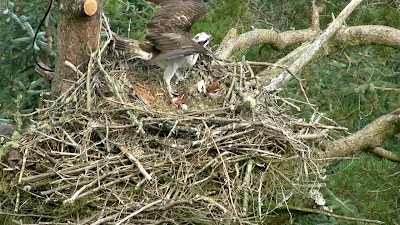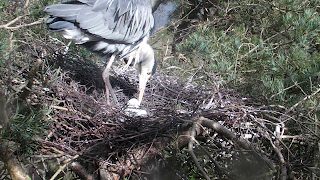 |
| Male brings a fish for the female and then takes a turn to incubate. |
The appearance of the sun and a spell of warm weather will be most welcome to ospreys all around the region as when reviewing last years’ report of nesting activity in the area it would seem that one of the factors affecting nest failure correlates to poor weather. Of a possible ten osprey nest sites as part of the Tweed Valley Osprey Project, only seven were successful in rearing young last year. Of the seven successful sites, all were early returners from their migration and had time to take full advantage of the early warm spring that we had last year. The disastrous wet summer that followed made it very difficult for not just ospreys but for many invertebrate feeders too.
 |
| Male white leg ring stands to reveal 3 eggs |
Our male bird, White leg ring SS is fifteen years old this year and he came from a nest in Aberfoyle originally, he is with his unringed partner and this is their tenth season together. They have raised 23 chicks in total since they got together and there will be three more to add to the list this year if all the eggs hatch out.
To date, we can celebrate that the Tweed Valley Osprey Project has raised a minimum of 160 osprey chicks since the start of the project in 2000. This is a fantastic conservation success story for the region and it is thanks to the Forestry Commission Scotland, in particular to Tony Lightley, Conservation Manager for South of Scotland and his team for creating nesting platforms to encourage the ospreys to breed here, monitoring sites and ringing the chicks.
The project is a partnership between Forestry Commission for Scotland , Kailzie Gardens and RSPB working together to provide the public viewing centres and trained volunteer staff who educate the public all about this great project and help to spread the news of the amazing story of the return of the iconic ospreys to full breeding success here in the Borders.
To date, we can celebrate that the Tweed Valley Osprey Project has raised a minimum of 160 osprey chicks since the start of the project in 2000. This is a fantastic conservation success story for the region and it is thanks to the Forestry Commission Scotland, in particular to Tony Lightley, Conservation Manager for South of Scotland and his team for creating nesting platforms to encourage the ospreys to breed here, monitoring sites and ringing the chicks.
The project is a partnership between Forestry Commission for Scotland , Kailzie Gardens and RSPB working together to provide the public viewing centres and trained volunteer staff who educate the public all about this great project and help to spread the news of the amazing story of the return of the iconic ospreys to full breeding success here in the Borders.
We are very grateful to Bill Irvine and his technicians from FCS because they do all the technical work, setting up the cameras and making the live images possible in the viewing centres with amazing new technology.
The centres are open daily from 10am to 5pm. On camera across the two centres there are the heron nest with three eggs, blue tits that are still nest building, jackdaws with 5 eggs, pond camera, meadow and river camera, and bird feeding stations as a constant hub of activity.
 |
| Heron turning her three eggs. |
Another exciting bit of news for the area was the presence of a white tailed sea eagle spotted flying over Cardrona Forest in the Tweed Valley on 10th April, this was reported in the bird listings, in Birdwatching magazine, so it is a reliable record.
Last year on 13th April, a Golden Eagle was photographed by Jan Lister as it flew over Innerleithen Town and she kindly sent the photographs to us at Tweed Valley Osprey Project. This is another exciting species to add to the list for the area.
 |
| Golden Eagle flying over Innerleithen - photograph by Jan Lister |
Last year on 13th April, a Golden Eagle was photographed by Jan Lister as it flew over Innerleithen Town and she kindly sent the photographs to us at Tweed Valley Osprey Project. This is another exciting species to add to the list for the area.
No comments:
Post a Comment
Please feel free to leave your comments on the blog. We've got a few house rules:
1. We (Forestry Commission Scotland) will review all comments and reserve the right to not publish them at our discretion.
2. There will be a time delay between submission and posting. Comments posted on a Saturday or Sunday won't be moderated until the following Monday.
3. Please make comments appropriate and relevant.
4. If you've a comment or question about Tweed Valley Ospreys , you can e-mail tweedvalleyospreys@gmail.com as we might not be able to respond here.
5. We won't publish comments that are abusive, indecent, unlawful or defamatory; published comments may be removed at any time; and individuals are personally liable for the comments they submit.
Thanks!